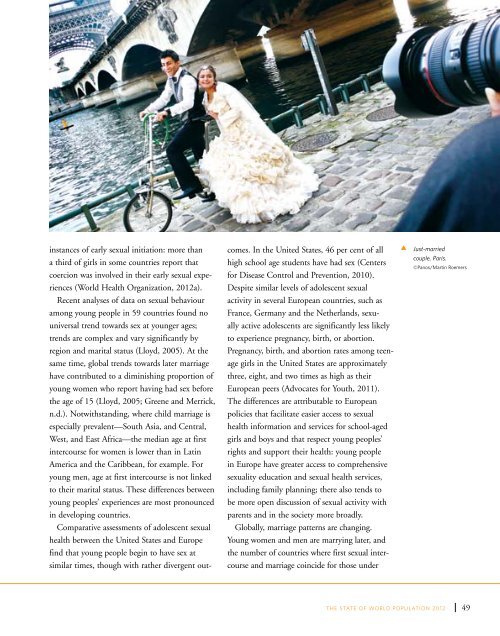State of World Population 2012 - Country Page List - UNFPA
State of World Population 2012 - Country Page List - UNFPA
State of World Population 2012 - Country Page List - UNFPA
You also want an ePaper? Increase the reach of your titles
YUMPU automatically turns print PDFs into web optimized ePapers that Google loves.
instances <strong>of</strong> early sexual initiation: more than<br />
a third <strong>of</strong> girls in some countries report that<br />
coercion was involved in their early sexual experiences<br />
(<strong>World</strong> Health Organization, <strong>2012</strong>a).<br />
Recent analyses <strong>of</strong> data on sexual behaviour<br />
among young people in 59 countries found no<br />
universal trend towards sex at younger ages;<br />
trends are complex and vary significantly by<br />
region and marital status (Lloyd, 2005). At the<br />
same time, global trends towards later marriage<br />
have contributed to a diminishing proportion <strong>of</strong><br />
young women who report having had sex before<br />
the age <strong>of</strong> 15 (Lloyd, 2005; Greene and Merrick,<br />
n.d.). Notwithstanding, where child marriage is<br />
especially prevalent—South Asia, and Central,<br />
West, and East Africa—the median age at first<br />
intercourse for women is lower than in Latin<br />
America and the Caribbean, for example. For<br />
young men, age at first intercourse is not linked<br />
to their marital status. These differences between<br />
young peoples’ experiences are most pronounced<br />
in developing countries.<br />
Comparative assessments <strong>of</strong> adolescent sexual<br />
health between the United <strong>State</strong>s and Europe<br />
find that young people begin to have sex at<br />
similar times, though with rather divergent outcomes.<br />
In the United <strong>State</strong>s, 46 per cent <strong>of</strong> all<br />
high school age students have had sex (Centers<br />
for Disease Control and Prevention, 2010).<br />
Despite similar levels <strong>of</strong> adolescent sexual<br />
activity in several European countries, such as<br />
France, Germany and the Netherlands, sexually<br />
active adolescents are significantly less likely<br />
to experience pregnancy, birth, or abortion.<br />
Pregnancy, birth, and abortion rates among teenage<br />
girls in the United <strong>State</strong>s are approximately<br />
three, eight, and two times as high as their<br />
European peers (Advocates for Youth, 2011).<br />
The differences are attributable to European<br />
policies that facilitate easier access to sexual<br />
health information and services for school-aged<br />
girls and boys and that respect young peoples’<br />
rights and support their health: young people<br />
in Europe have greater access to comprehensive<br />
sexuality education and sexual health services,<br />
including family planning; there also tends to<br />
be more open discussion <strong>of</strong> sexual activity with<br />
parents and in the society more broadly.<br />
Globally, marriage patterns are changing.<br />
Young women and men are marrying later, and<br />
the number <strong>of</strong> countries where first sexual intercourse<br />
and marriage coincide for those under<br />
t<br />
Just-married<br />
couple, Paris.<br />
©Panos/Martin Roemers<br />
THE STATE OF WORLD POPULATION <strong>2012</strong><br />
49
















